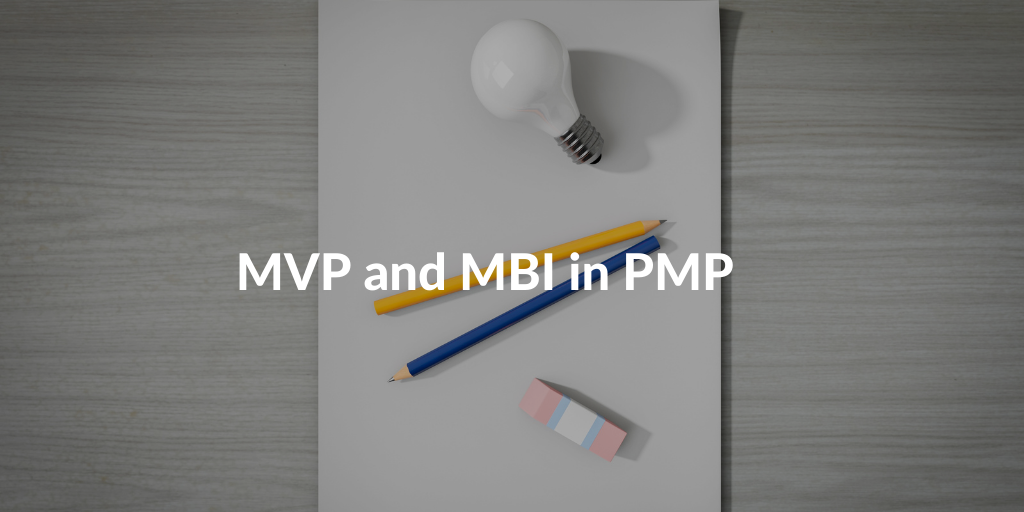Importance of MVP and MBI in Project Management

PMI’s PMP certification underwent a major change in 2021.
Unlike in previous years, the Exam Content Outline (ECO) balances the certification content between the traditional method of project management and the management of ongoing projects in Agile or Hybrid mode.
In fact, currently, half of the 180 PMP exam questions are about Agility.
Among the new concepts introduced in the official training material of PMI, we can highlight the Product Minimum Viable (Minimum Viable Product – MVP) and the Minimum Business Increment (MBI).
These concepts are widely used and come from the field of ‘Lean Startup’.
Within the new PMP training, they are included in the context of Agile methods.
Origin and definition of the MVP
MVP stands for Minimal Viable Product.
Frank Robinson introduced the concept of MVP in 2001 and sees it as the result of the process of parallel product and customer development.
Robinson has found that the team spends a lot of time adding features that do not add value, which creates additional risk. The solution is therefore to find the right size of the product for the company and for the customer. This should be enough to drive customer adoption and customer satisfaction.
In 2011, the term was repeated by Eric Ries in his Best-Seller “The Lean Startup” which presents his experiences in the creation of startups. He defines MVP as a new version of the product that allows the team to gather as much knowledge as possible about customer needs and validate them by testing hypotheses.
The goal is to minimize the effort and time in product development.
Eric Ries cites Dropbox as an example that used this concept and created a 3-minute video to explain how the product works. In a single day, the signatures of the people involved went from 5,000 to 75,000 without having the product.
MVP also allows for rapid feedback from clients on their interests and preferences without engaging in a cumbersome and haphazard development process that may ultimately be out of line with their expectations.
MVP in project management
A 2013 Standish Group study on IT development projects shows that only 20% of features are frequently used by customers and 50% of features are used very little. For the remaining 30% of the features, they are sometimes used and do not really help improve customer perception.
The results are consistent with the Pareto principle which is based on the following law: 80% of the effects are the product of 20% of the causes. Thus, the adaptation of this rule shows that 20% of the functionalities achieve 80% of customer satisfaction.
It should also be remembered that the first principle underlying the Agile Manifesto is to satisfy the customer by quickly and regularly delivering high added value features. The above results clearly show the importance of MVP in product design and development based on the concept of “minimal” and “viability”.
PMI also finds that creating an MVP inspires the team to achieve the goal of the project. When the results are too abstract or too far apart, teams can become discouraged or overwhelmed. Minimally viable products create short-term urgency and a sense of accomplishment.
All of these are valuable for the client, but also for the project team.
The idea of an iterative process is to create a version of a raw product and at the same time seek customer feedback. Thus, desired changes and design issues are identified at the right time. Each cycle is an opportunity to improve the product in an iterative and/or incremental way.
We can thus understand why this concept is taken up a few decades later, in the management of projects in Agile mode which is based on the prioritization and organization of the functionalities in Backlog and on the segmentation of the product in iterations that deliver the functionalities with strong added value first.
Characteristics of an MVP
1. Adequate value perceived by the customer:
The MVP must create sufficient value among customers that encourages them to use it.
2. Assurance on future profits
The MVP must also retain the first customers giving assurance and visibility on the development of the expected benefits.
3. Continuous improvement
The MVP is an iterative process that is part of a continuous improvement process in the sense that we have access to customer feedback which can be integrated over time into the future development of the product.
Successful MVP examples
1. Zappos
Zappos launched in 1999, the success story of Lean Startup. Its founder had the idea of selling shoes on the internet. The idea did not seem very promising in the sense that the shoes should be tried on before they are purchased.
Through a basic site, it showed pictures of shoes from nearby stores. With each order placed, he bought the shoes, repackaged them, shipped them, and provided after-sales service himself. Following the increase in sales, he was able to convince investors to finance his startup, which was subsequently bought out for $ 1 billion by Amazon.
2. Uber
At the time of its creation, Uber combined drivers available to carry passengers with people wishing to travel. As it developed, the company added other features to meet other customer requirements.
3. Airbnb
For Airbnb, two young designers knew that an important convention was being organized in San Francisco and that the rooms would not be available. They then rented the rooms in their apartment with basic services (Air bed and breakfast) hence the name of the company.
This is how they invented a new concept of the rental by eliminating intermediation.
4. Amazon
Amazon started out exclusively by selling books online through a simple web page before diversifying its offering to its customers. Its concrete examples show the importance of MVP in the incremental creation of value and in the control of the risk of non-compliance until the delivery of the final product.
Prioritization techniques
One of the fundamental characteristics of agile approaches is the maintenance of a product backlog that reflects the list of desired capabilities, written in the form of user stories. This list is prioritized by presenting the elements with the highest commercial value first.
Among the prioritization techniques mentioned in the context of PMP certification, we can mention:
- MoSCoW method: classify the functionalities in the categories Must Have (vital), Should Have (essential), Could Have (Comfort), and Won’t Have (Later). This method identifies an MVP.
- Kano method: identification of the really essential capacities from a classification of the functionalities or capacities in the categories Basic, Performance, or attractive.
- Pairwise comparison: consists of comparing each pair of user stories to determine the priority US.
- 100 points method: each stakeholder distributes a total of 100 points over the different user stories, which allows them to be prioritized.
The Minimum Business Value Increment (MBI)
Some projects improve or revise products that are already in service. As such, an MVP is not necessary to assess interest. Using the concept of minimum business value increment (MBI) is more viable.
MBI is the smallest amount (increment) of value that can be added to a product or service that benefits the business.
- Minimum: the smallest amount of value that can be achieved. Focusing on a minimum accelerates the realization of value and facilitates the management of work (time, cost …).
- Business: deliver value from a business perspective, aimed at customers and aligned with the business strategy of the company.
- Increment: the realization is done in an incremental way to validate the achievements and avoid waste and the risk of non-conformity of the final product or service.
The MBI provides a common guideline and direction within all of the company’s teams. Definition, implementation, and commissioning work are focused on delivering a high added value increment. It thus makes it possible to sequence the list of jobs based on the realization of value as the basic criterion.
The use of an MVP is therefore justified in the case of the discovery of certain elements of value and in a context of innovation (new customers, new products, and concepts). Whereas the MBI is used in the case where the customers or the product already exist and one wishes to improve the existing offer.
Haykel Kchaou

Haykel is an accredited PMP, PMI-PBA, PRINCE2 trainer with over 15 years of field experience and PMI Authorized Instructor.







